One thing to note about "Sleeping Hermaphroditus" is that there's multiple copies of that statue. Pliny wrote in Natural History that Polycles made a "splendid sculpture" of Hermaphroditus, so thanks to
Kopienkritik it's often firmly asserted that this statue is a copy of a Hellenistic bronze - but there's no other details of Polycles's statue. Anyway, there's lots of copies of this statue, which implies it was a frequently copied one as so many survived. It's part of a Roman motif of depicting sleeping women - frequently Ariadne was shown sleeping, and so was Venus/Aphrodite. The interesting thing about this Sleeping Hermaphroditus is there's elements of Dionysus in the depiction (lying on a leather skin on the ground) so the implication may be that Hermaphroditus is passed out drunk (the most famous version in the Louvre had a mattress added in the 17th century).
There's some other famous depictions of Hermaphroditus. Another much copied one is a Symplegma - entaglement - of Hermaphroditus and a satyr (this one also had many copies of it). These statues would have been displayed "in the round" but were designed to be approached from behind.

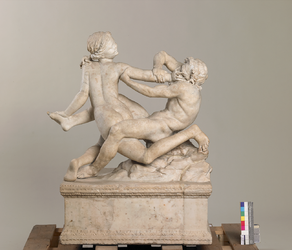
And that's the crux here. These statues were mirroring more typical types of statuary... but if you walked round to the back, you'd be surprised that the woman depicted actually had a boner.
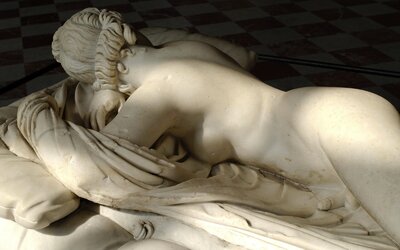

The Romans found it funny to subvert expectations. The likely purpose of these statues (displayed in gardens, theatres and gymnasiums) was genuinely a pickle surprise. They weren't deifying Hermaphroditus's gloriously non binary erotic form, they were pointing and laughing. That's why there were so many copies of these statues - having a dick joke statue in your
hortus meant you were cool. The Symplegma in particular is interesting - the satyr has seemingly happened across Hermaphroditus and launched himself because he thinks he's about to rape a nymph, but the chiton has slipped down to reveal a boner. The pose may suggests Hermaphroditus might actually be trying to draw the surprised satyr closer or stop him escaping - the foot's hooked round for example, and Hermaphroditus is smirking.
The other famous depictions of Hermaphroditus (or Aphroditus) are anasyrmata, which are statues where the subject lifts up their robes to reveal their genitals/buttocks (most famously the Venus Callipyge). This
is a holdover from Ancient Greece, which appeared to have made a lot of these sorts of statue -
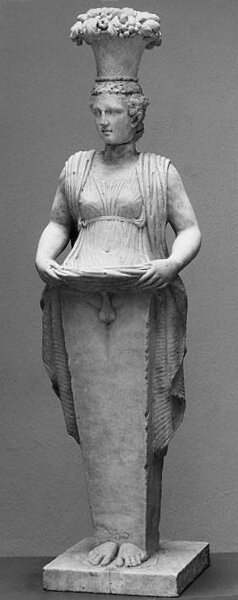
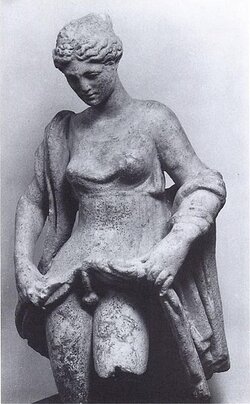



There's a couple of statuary traditions going on here - the first one most obviously feeds off Herma, which were statues that were essentially a bust and a cock.

These were located all over the place, especially outside temples and by crossroads. The reason for the weird form is essentially the Greeks and Romans thought phalluses were apotropaic - they warded off the evil eye. The Fascinus is a motif of male virility, and there's countless examples of winged penises, "fist and phallus" amulets and straight up just cocks sculpted onto buildings (I'm not talking about graffiti carved into buildings, but three dimensional penises put there by the builders). Likewise Anasyrma was seen as apotropaic, too - a way of warding off evil by shaming/mocking it (kinda like the Sheela-Na-Gig). So put the two together - an erect penis, and a woman lifting her skirts - and you've got double apotropaic protection. The Greeks also weren't above bawdy jokes either
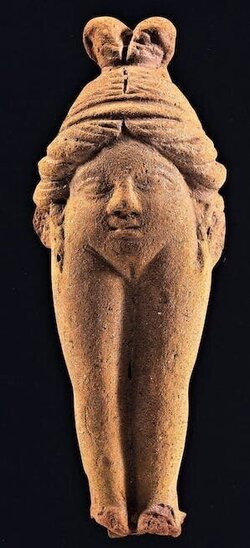
It's this sort of context that gets missed when someone like Ollie discovers a classical statue that ostensibly depicts a transgender woman, and thinks "Oh they must have worshipped this and thought it was hot". The Greeks and Romans certainly knew that intersex people existed, because they viewed a woman giving birth to an intersex child as a prodigy. That doesn't mean what people think it means, because they used that the word "prodigy" refer to a negative auspicia oblativa - in other words, the Gods had decided to communicate that
someone had pissed them off... although that did vary over time, going back to Pliny - "Persons are also born of both sexes combined—what we call Hermaphrodites, formerly called androgyni and considered as portents, but now as entertainments."
Similar thing with Ancient Roman views on gender. For example, adherents of the goddess Cybele would, on the
Dies sanguinis (Day of Blood), self flagellate and then castrate themselves, parade through the city holding their severed genitals aloft, and from then on they'd go around wearing bright yellow women's clothing and lots of makeup. This is typically defined as a transgender cult in modern parlance, but the primary sources link it to the story of Queen Stratonice of Syria, who had a vision to build a temple on a mountain. The King sent her there with Combabus, a stunningly handsome courtier. Because he was worried, he cut his genitals off and sealed them in a box before they left. Upon their return, the Queen (who'd been all over him) accused him of seducing her, so he opened the box in front of the King to prove his innocence and was greatly rewarded. Not long after a visiting woman fell in love with Combabus but upon discovering he was a eunuch killed herself in despair, so after that point he started dressing up as a woman to avoid it happening again. But without this additional context people read of the cult of the
galli and assume the galli were third gender.

























